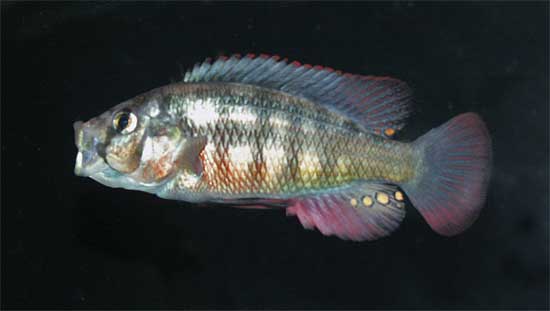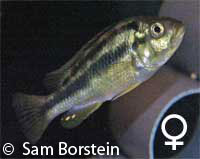Paralabidochromis sauvagei
(Pfeffer, 1896)
Rock Kribensis
Synonyms: Haplochromis sp. "rock kribensis", Paralabidochromis sp "rock kribensis"



Above: A male Paralabidochromis sauvagei "Uganda". Photo by Rick Borstein.
Etymology:
Genus- Para= similar (Greek), labis= tongs (Greek), chromis= perch (Greek). Meaning it is similar to Labidochromis.
Species- sauvagei= named after Sauvage.
Intro:
Paralabidochromis sauvagei, known as the Rock Kribensis, is a prety chessboard Haplochromis from Victoria. It is pretty and one of the more popular Victorian cichlids.
Until recently it was an undescribed species, but Seegers found in 2008 that what was in the hobby as Paralabidochromis sp. "rock kribensis" was actually Ptyochromis sauvagei. Therefore, what was in the hobby as Ptyochromis sauvagei had to be redescribed and became Ptyochromis fisheri and the type for the genus as Ptyochromis sauvagei should really be a Paralabidochromis.
Distribution:
Rock Kribs are found at shallow rocky zones of Lake Victoria. Some location varieties they are found at are Kissenda Island, Chamagati, Python Island, Buyago, Ngoma, Matwinki Island, Chamagati, Makobe Island, and the northern Mwanza Gulf in Lake Victoria (Seehausen, 1996).
Size, Maturity, and Sexual Dimorphism:
Size: Males- 5 inches, Females- 3.5 inches
Maturity: .75 inches
Sexual Dimorphism: Males are larger than females, and are a lot more colorful than the females which are brownish-gray.

Above: A female Paralabidochromis sauvagei "Uganda". Photo by Sam Borstein.
Care:
Small Rock Kribs can easily be kept and bred in a 20 gallon tank with some rocks. As they get larger a 40 would be suitable. I recommend putting them with Malawians because they are good dither fish, and although they aren’t aggressive, can easily defend themselves. They can also be mixed with other Vics, but be cautious that they are not similar in appearance as they can easily hybridize.
This fish is also easy to care for. They are not demanding and are quite hardy. This fish will thrive if weekly water changes are done and spawn even more frequently.
Diet:
This fish is not picky. This fish is an omnivorous in the wild. It's best to feed a mixed diet of flakes and pellets.
Breeding:
This species breeds in a typicl Victorian cichlid fashion. From the spawns I’ve seen, there is usually about 40-45 eggs in adult breeders. The females were excellent holders and held for 24 days before I stripped her and got fully developed fry.
The fry are not that large, so feed them baby brine shrimp to get them going. These fry are extremely fast growing and will begin to show color at around an inch in length.
Conclusion:
Rock Kribs are nice fish. They can be mixed into community set ups and are an easy BAP. This fish is available around many clubs and is relatively cheap.
References:
- IUCN. IUCN Red List of Threatened Species. <http://www.iucnredlist.org>.
- Pfeffer, G. J. 1896. Die Fische Ost-Afrikas. In M bius, F. (ed.). Deutsch-Ost-Afrika, Band III. Die Thierwelt Ost-Afrikas und der Nachbargebiete Wirbelthiere, (Separatum: 1–72): pp. i–xviii þ 1–72.
- Seegers, L. (2008) The fishes collected by G. A. Fischer in East Africa in 1883 and 1885/86. Zoosystematics and Evolution, 84, 149–195.
- Seehausen, O. (1996) Lake Victoria Rock Cichlids. Verduyn Cichlids, Germany, 304 pp.
